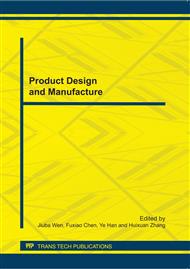p.397
p.403
p.410
p.414
p.418
p.426
p.432
p.436
p.440
Simulative Analysis of Carry Out Fontusing near Field Photolithography
Abstract:
Adopting the concepts of integration and cumulative sum of exposure energy in the intersecting region between two fabricated line segments, an analytical method of exposure energy density equation for near field photolithography of font fabrication is established. At the same time, cutting photoresist into limited nodes, together with the use of the integral equation of exposure energy density and Mack’s developing model, the full-width at half maximum (FWHM) and fabrication profile of font can be calculated. As analyzed in the study, in the intersecting region between two fabricated line segments, the greater the exposure energy, the deeper the fabrication depth; while in the straight-line region of fabricated lines, as the exposure energy is equal, all the fabrication depths are the same. The research analysis of the paper can be a reference for near field photolithography of font.
Info:
Periodical:
Pages:
418-425
Citation:
Online since:
October 2011
Authors:
Price:
Сopyright:
© 2012 Trans Tech Publications Ltd. All Rights Reserved
Share:
Citation:


